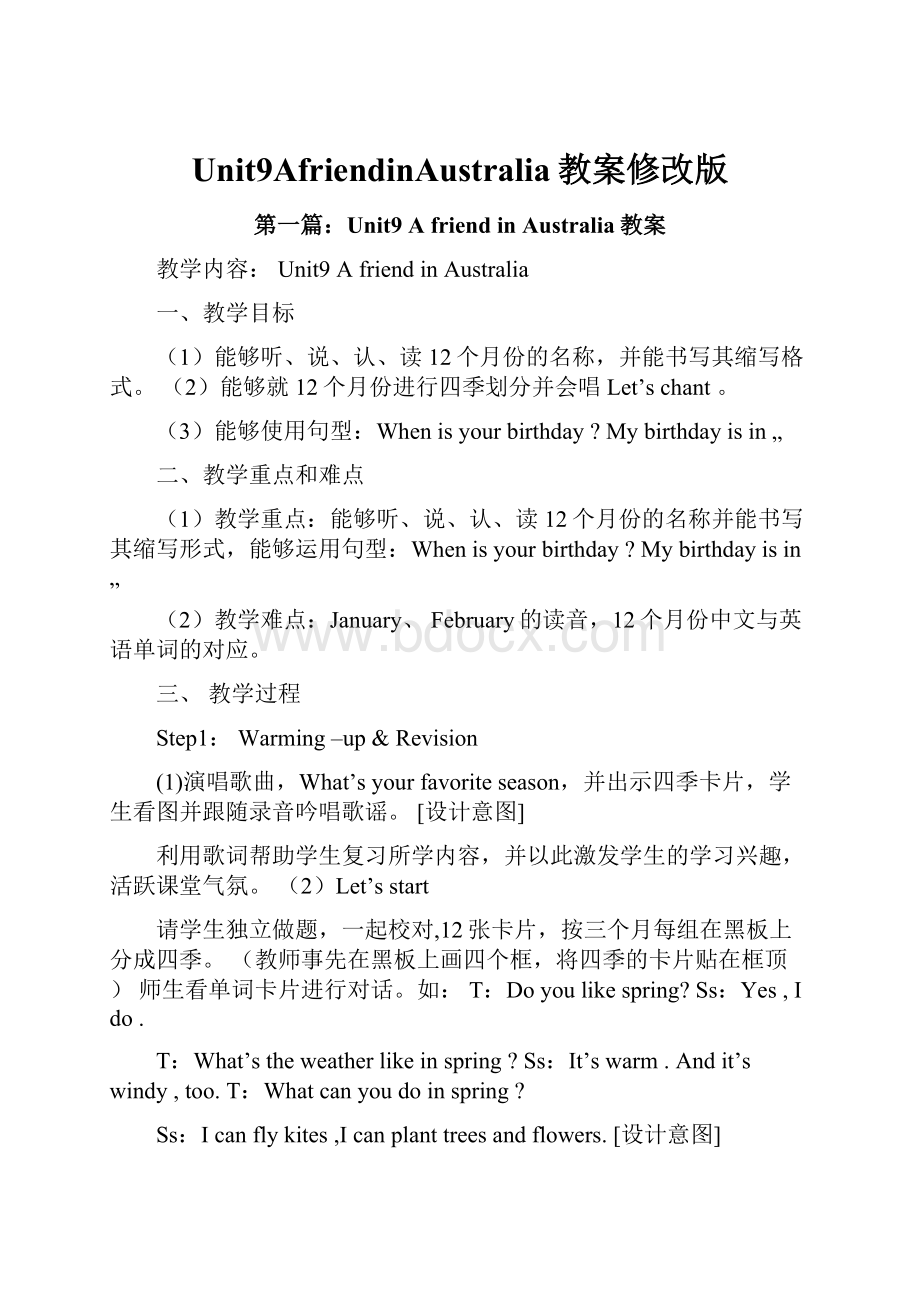Unit9AfriendinAustralia教案修改版.docx
《Unit9AfriendinAustralia教案修改版.docx》由会员分享,可在线阅读,更多相关《Unit9AfriendinAustralia教案修改版.docx(26页珍藏版)》请在冰豆网上搜索。

Unit9AfriendinAustralia教案修改版
第一篇:
Unit9AfriendinAustralia教案
教学内容:
Unit9AfriendinAustralia
一、教学目标
(1)能够听、说、认、读12个月份的名称,并能书写其缩写格式。
(2)能够就12个月份进行四季划分并会唱Let’schant。
(3)能够使用句型:
Whenisyourbirthday?
Mybirthdayisin„
二、教学重点和难点
(1)教学重点:
能够听、说、认、读12个月份的名称并能书写其缩写形式,能够运用句型:
Whenisyourbirthday?
Mybirthdayisin„
(2)教学难点:
January、February的读音,12个月份中文与英语单词的对应。
三、教学过程
Step1:
Warming–up&Revision
(1)演唱歌曲,What’syourfavoriteseason,并出示四季卡片,学生看图并跟随录音吟唱歌谣。
[设计意图]
利用歌词帮助学生复习所学内容,并以此激发学生的学习兴趣,活跃课堂气氛。
(2)Let’sstart
请学生独立做题,一起校对,12张卡片,按三个月每组在黑板上分成四季。
(教师事先在黑板上画四个框,将四季的卡片贴在框顶)师生看单词卡片进行对话。
如:
T:
Doyoulikespring?
Ss:
Yes,Ido.
T:
What’stheweatherlikeinspring?
Ss:
It’swarm.Andit’swindy,too.T:
Whatcanyoudoinspring?
Ss:
Icanflykites,Icanplanttreesandflowers.[设计意图]
采用师生对话形式引导学生复习与本课关系密切的单词,为后面的教学做不可或缺的铺垫。
Step2:
Presentation
1、教学单词MarchAprilMay
(1)T:
whichmonthdoyoulikebestinspring?
(如有学生点到March,,就引入March教学,其余两个单词教师可以通过手势,提问学生T:
Before/AfterMarch,itis„自然引入)
(2)指导读并板书
教师指出划线部分的读音,而后请学生拼读
March
April
May
[设计意图]
通过展示商标中的英语,能引领学生关注身边的英语。
T:
SpringisMarch、AprilandMay.(师总结)
2、教学JulyJuneAugust
(1)教师指着“夏季”方框,画一轮艳阳,表情夸张地说
T:
Oh,summerisafterspring,Andit’shot,veryveryhot.T:
Doyoulikesummer?
S:
Yes,Ido.
T:
Whatcanyoudoinsummer?
S1:
Icanswiminthelake.S2:
Icaneatice-cream.
T:
Whichmonthdoyoulikeinsummer?
根据学生的回答随机引入单词教学,其余的两个通过afterandbefore引入。
(2)指导读并书写.
跟读单词July和June,并且比较两个单词中“U”的发音。
T:
NowLet’swritetheword“July”(JuneAugust„)ontheblackboard.Pleaseholdupyourfingerandwriteitintheair.
(教师将单词慢慢地写入黑板上的四线格中,同时让学生书写所学过的单词,并指导字母的占格及写法,同时示范单词的发音。
)[设计意图]
在板书单词的同时进行拼写和发音训练,有利于学生形成正书写和规范发音的习惯。
(3)师生一起做“BeforeandAfter”游戏T:
Now,Let’splayagame.
教师向学生宣布游戏规则:
在March→August六个单词中,教师随机给出一个单词并举左手或右手,举左手表before,举右手表after,要求学生反应迅速,口齿清晰。
[设计意图]
通过猜单词游戏活跃课堂气氛,营造英语学习的氛围。
3、教学SeptemberOctoberNovember
(1)当游戏进行到最后的时候,教师给出单词August并举右手,引出September。
学生跟读并书写其简写形式。
教师在秋季方框上画上黄色落叶,做出树叶飘落的手势,并以开玩笑的口气
T:
Oh,Septemberisinfall.Becauseleavesareyellowandbeginto“fall”now.whichothertwomonthsareinfall?
Ss:
OctoberandNovember.
教师应注意学生的发音并引导学生拼读及缩写形式,跟读October,辨别两个”O”的发音。
(2)记忆词形:
通过对首字母的添加使Sep.Oct.Nov.与数字9.、10.、11联系起来。
具体方法:
S-g(把S的起笔处和弯倒处连接起来),O-10(前加一竖),N-11(加粗N的两竖)。
[设计意图]
使学生将单词与自己熟悉的数字想联系,可以适当降低学生记单词的难度。
(3)找出三个词的共同点,都以-ber结尾等。
(师提醒冬天的第一个月即12月也是以ber结尾的。
)
4、教学DecemberJanuaryFebruary
(1)教师在”冬季”方框中画上雪花,做出冷的样子说
T:
Nowwehavethelastseason-----winter.Howcolditis!
Itsnows!
Butmyfavoriteseasoniswinter.why?
Guess?
S:
:
Youlikesnow?
Youcanplayinthesnow?
Youcanmakeasnowman?
T:
((表赞许)Youareright.Butthatisnotall.Themostimportantreasonisthat------mybirthdayisinwinter.师指着剩余的三个月的卡片
T:
:
Theyareallinwinter.Oneofthemismyfavoritemonth.whatisit?
S:
IsitDecember?
教师挑出December卡片,帮助学生正确发音,并拼读和书写其简写形式。
T:
:
Yes,IlikeDecember.Butit’snotmyfavoritemonth.S:
JanuaryorFebruary?
师特别注意纠正学生这两个单词的发音,给出清晰的示范,要求学生准确跟读,最后,教师做出回答:
MyfavoritemonthisFebruary,becausemybirthdayisinFebruary.(师板书:
MybirthdayisinFebruary.)
T:
MybirthdayisinFebruary.Whenisyourbirthday?
(学生作答)
(2)学生之间进行pairwork,两人一组练习句型。
教师挑选1-2组进行“连锁回答”要求发音清晰、流畅。
[设计意图]
小组合作学习有利于学生积极参与课堂活动,并开动脑筋。
Step3:
Consolidation
1、教师放Let’slearn部分的录音,学生跟读。
教师出示月份转盘请学生结合主情景图的内容用“Whenisyourbirthday?
Mybirthdayisin„„句型做游戏,复习巩固所学单词。
2、找出十二个月单词的共同点。
(首字母大写)
3、总结缩写方法。
请学生观察总结12个词的缩写方法,教师总结。
4、Game1:
listenandshow
步骤一:
教师出示单词并说,学生跟读并出示相应的手指。
步骤二:
全体同学伏在桌子上,头低下。
一学生报单词,其余学生出示相应的手指数,师巡视并揭晓答案。
[设计意图]
让学生独立思考,有利于教师关注到每一位学生的学习效果,从而调整对不同学生的要求,保护他们学习英语的自信心。
5、Game2:
lookandguess
方法:
教师只出示字母卡片的第一个字母,让学生猜一猜是哪一个单词。
可采用男女生比赛的形式。
Step4:
Homework:
1熟读单词并准备好默写十二月单词的缩写。
2制作班级同学生日统计表,调查同学生日。
[设计意图]
进一步为学生创设真实的语言环境,让他们在生活中使用语言,训练他们的口语表达能力,这样的调查活动促使学生在实践活动中运用所学英语,增强对所学英语的体验,同时培养学生的合作精神。
第二篇:
Unit9优质课教案
Period1教学目标语言目标:
1、Masterofthesimplepastpassivevoice.
2、Learnaboutthehistoryoftheinvention,willusethefollowingbasicsentences.
Whenwasthecarinvented?
Itwasinvertedin1885.Whoweretheyinventedby?
Theywereinvertedby……Whataretheyusedfor?
Theyareusedforseeinginthedark认知目标
Activevoiceandpassivevoicecleardifferencestobeconsolidatedthroughpracticeandapplication情感目标
1、Throughthisunitstudentslearntounderstandthescienceofhumaninventioncreatedawealthofmaterial
2、Developstudentstheabilitytocreateandinventthedesire
教学重、难点
Simplepasttenseofthepassivevoice
1、Basicstructure:
be(was/were)+PastparticipleoftheverbAthiefwascaughtlastnight.Theywereaskedtospeakatthemeeting.TeachingaimsLearningthesimplepastpassivevoiceandthespecialquestions.
TeachingSteps:
Teachingofnewlesson1.Warm-upFirstplayed“Twinkle,Twinkle,LittleStar“song,sothatstudentslisten,learnandsing.Mobilizetheenthusiasmofthestudentstostimulatetheirenthusiasmforlearning.
2.Presentation
1)Teaching:
Picturesbycartoteach"Whenwasthecarinvented?
Itwasinventedin......"
Choosethetwoinventionsoftheseandaskstudentstodiscusswheneachonewasinvented.Forexample,youmightchoosecar,andlightbulbs.Teachersleadthereadingandtheimportantsentenceswritingontheblackboard
Asktheclasstorepeatthequestionsandanswers.[T=Teacher,S=Student]T:
Whenwasthecarinvented?
(Classrepeat.)T:
Good.Nowxxx,whatwasyourguess?
S1:
in1912T:
OK.xxx,repeatafterme.Thecarwasinventedin1912.Repeattheprocesswithseveraldifferentinventions.2)教学Whowerethelightbulbsinventedby?
Andwhataretheyusedfor?
ShowthepictureofEdisonandlightbulbs.TellthestudentsEdisoninventedlightbulbs.Thenaskthestudentstoanswerthequestionsbelow.
T:
Whowerelightbulbsinventedby?
(Classrepeat)T:
Good.NowClassrepeatafterme.TheywereinventedbyEdison.3.Pairwork
Askthestudentstobefamiliarwiththewordsbelowaccordingtothepicturesoncomputer.Telephone,calculator,car,personalcomputer,TV,lightbulb,microwaveoven.The1a,1c,2cofthelanguagepointstogether,toldthestudentstoeachothertoanswerquestions.Andusejustlearnedtopracticethetargetsentence.Finally,samplingafewofthestudentsintheclassbeforethem,accordingtotherequirementsofdialogue4.Let’smakeupsomepuzzles:
Guessinggame,Show4picturesforstudentstoguessthewordbasedonthecontent.IgivethemapieceofcandyasencouragementIftheyanswerright.5.Teaching1b,
Firstofall,helpstudentstocleartheheadlines.Then,listening,recordingreleasedtwice,firsttoallowstudentstolisten,thesecondtimeforstudentstocompletetheaudiocontentbasedon1b.Andthenchecktheanswers
6.1cPairwork:
Firstpresentadialogtoallowstudentstopracticeconversation,andthenfindtwogroupsofstudentstopracticethedialoguepractice.
Thenshowthepicturesandtime,allowingstudentstopracticethedialogueinpairs.Finally,asktwogroupsofstudentstothefronttopracticethedialogue.7.Showthepictures,accordingtothepicturestosaytheEnglishwords,andthenunderthepicturestosaybasicsentencesofthisclass.
8.Challenge:
Trytobeaninventor!
Doyouwanttobeaninventor?
Lookatthesepictures,youcanmakeinventions.
9.Knowledgepoint:
1)Thecompositionofthepassivevoice:
2)Thedifferenceof“beusedfordoingsth.”,“beusedassth.”,“beusedbysth.”,“beusedto”
Letonestudentreadit.Otherslistentoherorhim.10.Knowledgefeedback:
1)Fillintheblankswithrightwords.
2)Writethewordsaccordingtothesentencemeaning.3)Accordingtothesentencemeaningandpicturestowritewordsandphrases.4)TranslatetheChinesesentencesintoEnglish.11.Summary:
Inthisclass,wehavelearnedtotalkaboutthehistoryofinventionswithpassivevoice.We’vealsodonesomelisteningpracticeinunderstandingthetargetlanguageinspokeconversation.Andwe’vedonemuchoralpractice,usingthetargetlanguage.
12.Homework
Readaboutaninventionusingbooksfromthelibrary,orbylookingupinformationontheInternet.Thestudentswriteupashortreportanddrawasimplepictureoftheinventionorbringaphotoofit.Askeachstudenttoshowthepictureandreadhisorherreporttotheclasstomorrow.
13.Quotetosharewiththestudents:
Believeinyourself,bestrong,Beyourbestanddon'tevergiveup.设计理念:
现代教学手段,如录音、录像、幻灯、,电脑多媒体等是现代外语教学中的重要手段,为我们大幅度地提高英语教学质量起着非常重要的作用,使用现代教学手段。
充分的利用他们,让现代化设施在教学过程中发挥最大的功用。
新的教材应以新的教学理念为导引,以新的教学法组织教学,这就要求我们打破常规.苏霍姆林斯基说过:
“人的内心深处有一种根深蒂固的需要,总希望自己是第一个发现者、研究者、探讨者”。
为了使学生学习兴趣更强烈、更持久,做到自主学习,有所发现,我让学生通过不同形式进行反复对话练习并调动他们的积极性。
由于学生兴趣盎然,思维也特别活跃,积极性也被调动了,真正让学生“乐学”、“会学”。
“学生是学习的主人”,我会将这一教学中永远的真理体现在课堂中。
第三篇:
4Bunit9教案
4B/Unit9第2教时
3.教学目标
(1)认知目标
A进一步操练第一课时的句型:
What'sfor„?
Where'sthe/my„?
及四会单词glass,cup,bread,fridge等。
B学习新的四会句型:
Wherearemy/the„„?
并注意单复数区分There'sno„„in/on/near„„
C掌握四会单词:
knofe,fork.Egg.Bread.等。
(2)能力目标
A学生能自由替换练习句型,能够在真实语言环境下运用句型。
B学生能综合第一课时和第二课时所学内容,根据所提供的情境,进行小组活动,表演对话。
(3)情感目标
使学生从“要我说”“要我学”变成“我要说”“我想试一试”。
让学生感受到与日常生活的紧密联系,使学生觉得自己能够用英语进行真实的日常生活对话,从而获得英语学习的成功感,自豪感。
从根本上培养和保持了学生学习英语的兴趣。
心理学认为:
成功感是人的深层心理需要。
(4)教学安排
本单元共安排四课时,我今天所说的是第二课时。
(5)教学准备
教师:
实物、课件学生:
食品、刀叉等实物
二教学程序
Step1Warmingup
Wellbegun,halfdown.良好的开端等于成功的一半。
上课刚开始,让学生在轻松的音乐声中步入课堂,使他们的听觉、视觉、思维都进入英语的状态。
我选用了两首歌曲。
第一首是前一单元的“What'sintheclassroom?
”,第二首是“Cheeseandsandwiches.”,由这首歌自然过渡到复习食物类和餐具类单词。
Step2Revision
分三个环节复习:
1利用事物,师生自由对话
可用句型:
What'sthis?
Whatarethose/these?
What'sonthedesk?
注意对单词单复数形式的操练。
2Magiceyes游戏:
What'sinthebag?
引出单词:
eggbread并板书。
根据学生的回答渗透句型:
There'sno„in/on„
并且抓住课堂契机,巩固这一句型。
板书句型。
如:
Isthereanywaterintheglass?
No.There'sno„in„
3Magicears听敲击餐具的声音,猜单词。
带